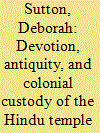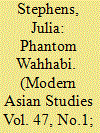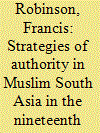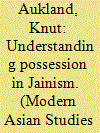|
|
|
Sort Order |
|
|
|
Items / Page
|
|
|
|
|
|
|
| Srl | Item |
| 1 |
ID:
121949


|
|
|
|
|
| Publication |
2013.
|
| Summary/Abstract |
The paper examines the model value of the Mughal period in MARG, the leading art journal of 1940s and 1950s India. It combines a discussion of some of the key historiographical questions of Indian art history and the role played by specific art historians, including European exiles who were among the contributors to the journal, with broader questions on the interaction of national cultural identity with global modernism. In this context, the Mughal period-celebrated in MARG for its synthesis of foreign and indigenous styles-was consistently put forward as an example for contemporary artists and architects. From its inception in 1946 until the 1960s the review favoured a return to the spirit of India's prestigious artistic past, but not to its form. Its editorials and articles followed a clearly anti-revivalist and cosmopolitan line. It aimed at redressing misunderstandings that had long undermined the history of Indian art and surmounting the perceived tensions in art and architecture between a so-called Indian style and a modern, international one.
|
|
|
|
|
|
|
|
|
|
|
|
|
|
|
|
| 2 |
ID:
121948


|
|
|
|
|
| Publication |
2013.
|
| Summary/Abstract |
In 1904, the British Indian government passed the Ancient Monuments Protection Act and, in doing so, radically enlarged the state's bureaucratic claim to structures defined, for the purposes of the Act, as monuments. The project of conserving the Hindu temple was beset by disagreements. The claims of the colonial state and local Hindu devotees were separated by different precepts about religiosity and alternate orders of aesthetics, time, and history. However, it is clear that there were also confluences: legislative authority could masquerade as custody of the antiquarian and, in practice, the secular veneration of material antiquity blurred with Hindu divinity. This paper combines an exploration of the principles of archaeological conservation, as they were formed in the European bourgeois imagination, and then traces their transfer, though imperial administration, to case-studies of specific temples. Of particular interest is the deployment of the Act by local administrations and the counter-challenges, appropriations, and manipulations of the same legislation. How were the aesthetic codes of conservation-and the legislation that sought to order and enforce their introduction-compromised by religious claims and practices?
|
|
|
|
|
|
|
|
|
|
|
|
|
|
|
|
| 3 |
ID:
121951


|
|
|
|
|
| Publication |
2013.
|
| Summary/Abstract |
The creation of Assam as a new province in 1874 and the transfer of Sylhet from Bengal to Assam provided a new twist in the shaping of the northeastern region of India. Sylhet remained part of Assam from 1874 to 1947, which had significant consequences in this frontier locality. This paper re-examines archival sources on political mobilization, rereads relevant autobiographical texts, and reviews oral evidence to discover the 'experienced' history of the region as distinct from the 'imagined' one. The sub-text of partition (Sylhet) is more intriguing than the main text (Bengal), because events in Sylhet offer us a micro-level study. Generations of historians-writing mostly in Bengali and relying on colonial archives-have tended to overlook the mindset of the people of Sylhet. This paper, on the basis of an examination of combined sources, argues that the new province was implicated in overlapping histories, across Bengal-Assam borders. The voice of the indigenous-mostly Hindus but partly Muslim-elites were dominant from 1874 onwards. However, the underdogs-particularly 'pro-Pakistani' dalits (lower-caste Hindus) and madrasa-educated 'pro-Indian' maulvis-emerged as crucial players in the referendum of 1947. Hardly any serious study, however, has focused on the Sylhet referendum-a defining moment in the region. This study of the Sylhet referendum will reveal a new dimension to the multiple responses to these issues and provide a glimpse of the 'communal psyche' of the people in this frontier district, rather than a binary opposition between 'religious' and 'secular' forces.
|
|
|
|
|
|
|
|
|
|
|
|
|
|
|
|
| 4 |
ID:
121945


|
|
|
|
|
| Publication |
2013.
|
| Summary/Abstract |
A hundred years ago, pre-puberty marriage for girls was the norm among South Indian Tamil Brahmans, and Brahman girls received little or no education. By the 1940s, child marriage had largely ended and girls' education was improving gradually. Today, girls' educational standards more or less match that of boys', and many Brahman women are also employed outside the home. In relation to marriage and education in particular, the position of women has greatly improved, which is regarded by Tamil Brahmans themselves as a sign of their modern, educated, professional, middle-class status, whereas extreme gender inequality formerly indicated their traditional, high-caste status. This paper examines how female marriage, education, and employment are interrelated and how they have changed among Tamil Brahmans, particularly in the Eighteen-Village Vattima subcaste, which continued child marriage until the 1970s. Among Tamil Brahmans, as both women and men recognize, a real reduction in gender inequality has occurred. Moreover, Brahman men have more readily ceded status to Brahman women than Brahmans together have to non-Brahmans, so that there is a striking contrast today between persisting ideas of caste superiority and diminishing gender inequality.
|
|
|
|
|
|
|
|
|
|
|
|
|
|
|
|
| 5 |
ID:
121950


|
|
|
|
|
| Publication |
2013.
|
| Summary/Abstract |
This paper investigates some key questions regarding the socio-cultural implications of a relatively understudied print media, the literary miscellany, its production and consumption in early twentieth century British Bengal. Through a study of Ramananda Chattopadhyay's Prabasi, a major literary journal that set the trend of sacitra masik patrika or illustrated monthly magazine in Ba?gla, its literary innovations and editorial interventions, this paper explores how periodical reading and the notions of aesthetics and culture that it cultivated became intimately tied up with questions of middle class identity and class differentiation. It shows how this pioneering sacitra patrika came to command a literary and visual space that, by the time of the Swadeshi years, was conceived as co-extensive with the future sovereign nation. Problematizing notions of a quotidian practice like leisure-reading that had become integral to the lifestyles of an expanding middle class, this study shows how Prabasi not only lent new meanings to ideas of sustained interest and participation in public life amongst its readers, but that it also represented a self-consciously, high-brow cultural sensitivity that the Bengali bhadralok were to claim and safeguard as their own.
|
|
|
|
|
|
|
|
|
|
|
|
|
|
|
|
| 6 |
ID:
121944


|
|
|
|
|
| Publication |
2013.
|
| Summary/Abstract |
In the late 1860s and early 1870s the British colonial government in India suppressed an imagined Wahhabi conspiracy, which it portrayed as a profound threat to imperial security. The detention and trial of Amir and Hashmadad Khan-popularly known as the Great Wahhabi Case-was the most controversial of a series of public trials of suspected Wahhabis. The government justified extra-judicial arrests and detentions as being crucial to protect the empire from anti-colonial rebels inspired by fanatical religious beliefs. The government's case against the Khan brothers, however, was exceptionally weak. Their ongoing detention sparked a sustained public debate about the balance between executive authority and the rule of law. In newspapers and pamphlets published in India and Britain, Indian journalists and Anglo-Indian lawyers argued that arbitrary police powers posed a greater threat to public security than religious fanatics. In doing so, they embraced a language of liberalism which emphasized the rule of law and asserted the role of public opinion as a check on government despotism. Debates about the Great Wahhabi Case demonstrate the ongoing contest between authoritarian and liberal strands of imperial ideology, even at the height of the panic over the intertwined threat of Indian sedition and fanatical Islam.
|
|
|
|
|
|
|
|
|
|
|
|
|
|
|
|
| 7 |
ID:
121946


|
|
|
|
|
| Publication |
2013.
|
| Summary/Abstract |
This paper aims to demonstrate how 'the religious' is conceptualized and practiced among urban Indian entrepreneurs. It investigates a continuum of religious sentiment and practice, including non-religious elements, rather than a fixed repertoire of belief and ritual. These religious orientations range from the incorporation of certain Hindu religious practices into the business setting to a denial of any substantive role religion may play in the lives of entrepreneurs and the imbuing of religious dispositions with secular meaning. I argue in this paper that the religious and quasi religious practices of India's new social and economic elite are geared primarily towards the enhancement of their 'flexible' lifestyles. The study also makes a claim that modern urban Hinduism accommodates hybrid secular-sacred religious beliefs and practices.
|
|
|
|
|
|
|
|
|
|
|
|
|
|
|
|
| 8 |
ID:
121943


|
|
|
|
|
| Publication |
2013.
|
| Summary/Abstract |
Starting from the position that authority is constantly a work in progress, this paper examines authority in Muslim South Asia at a time when Muslims felt the challenge of rule by another civilization. It examines the strategies in sustaining their authority: of religious leaders, of Unani hakims and of literary leaders. In all three areas there is a rejection of the Persianate Mughal past and an embracing of Arab models, of the Prophetic model, and in various ways a drawing on British models and British authority. The paper also looks at the strategies of the rulers noting, amongst other things, how the British drew heavily on Mughal models just as Indian Muslims were letting them go, and how, since independence, Muslim rulers have drawn on a mixture of Western, Arab and Prophetic sources. There is also a running discussion throughout the paper of the revolutionary shift towards rooting authority in society at large, and the development of techniques to do so.
|
|
|
|
|
|
|
|
|
|
|
|
|
|
|
|
| 9 |
ID:
121952


|
|
|
|
|
| Publication |
2013.
|
| Summary/Abstract |
British colonial intervention in India had sought to establish an exclusive sovereignty as was embodied in the modern state of the West. India had a tradition of existence of multiple sovereignties even during the times of strong imperial powers. Pre-colonial imperial powers had enjoyed symbolic sovereignty particularly over forest and hill areas, while local powers had undisputed sovereignty over resources and people in their territories. The British colonial state disturbed this shared sovereignty by assimilating the local sovereign powers into the state through a programme of colonial modernity, treaties, agreements and by force. This process produced contested histories. However, local powers such as the Gond Rajas were, to some extent, reduced to a subordinate position.
|
|
|
|
|
|
|
|
|
|
|
|
|
|
|
|
| 10 |
ID:
121947


|
|
|
|
|
| Publication |
2013.
|
| Summary/Abstract |
Possession among Jains remains an almost unexplored field of study. Based on fieldwork at a Jain pilgrimage site in India, this paper presents ethnographical material on a hitherto unknown oracular possession cult. The paper looks at the ways in which Jains themselves understand and sometimes critique possessions, as a way of understanding Jainism itself. The ethnographic material is presented on the background of other cases of Jain possession, both in scriptures and other accounts, in an attempt to show how possessions challenge our understanding of Jainism as a religion. Furthermore, possession is not one thing. There are various types of possession-depending for instance on who possesses-and they have different implications in the Jain scheme of things.
|
|
|
|
|
|
|
|
|
|
|
|
|
|
|
|
|
|
|
|
|